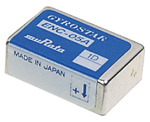Electronic parts that age requested
Since the advent of PCs, the boundary between office equipment and personal equipment became blurred. The world of communications continues to expand today.
As PCs gain popularity, Murata’s CERALOCK, ceramic resonator to determine a PC’s processing speed, and noise suppression component, ferrite beads, became big hits.

Three-terminal capacitor

Ferrite beads

CERALOCK
Headphone stereos became a fad. The downsizing of electronic components allowed full-scale stereo sound to fit in a pocket-sized player.
Chip multilayer ceramic capacitors became the mainstream, as surface mounted devices (SMD) on the substrate of equipment with downsizing demand, such as mobile audio equipment and video cameras.

Chip multilayer ceramic capacitor
Digitalization of audio equipment became complete through CD technology.
Murata’s active filter for audio equipment removes folding noise inherent in PCM audio.
It became indispensable for digital-age music.

Active filter
The home video camera was another item that followed the downsizing trend.
Image stabilization function with piezoelectric vibrating gyroscope became essential in filming equipment.

Piezoelectric vibrating gyroscope
Topics of Murata
In 1983, Izumo Murata Manufacturing Co., Ltd. was established.
The Yasu Plant in Yasu-cho, Yasu-gun, Shiga in 1987 and the Yokohama R&D Center in 1988 were established to fortify Murata’s R&D capability.
In 1988, Murata Electronics (Thailand), Ltd. was established in Thailand.